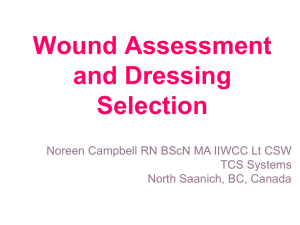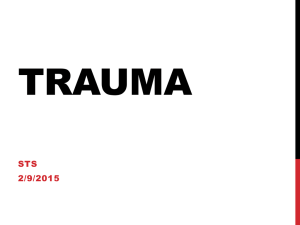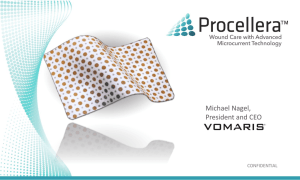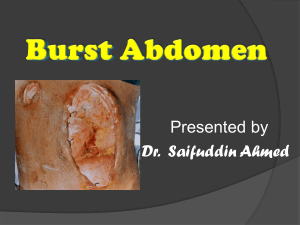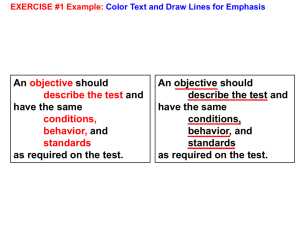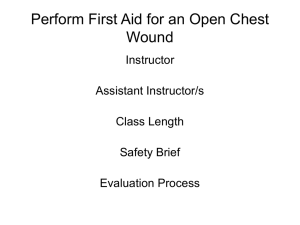EXCOR_Wound_Care
advertisement
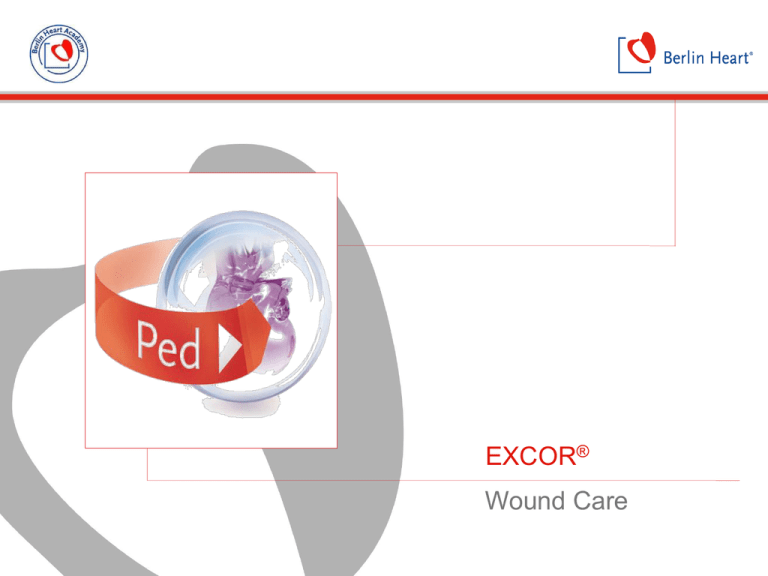
EXCOR® Wound Care 1 EXCOR® Wound care : General information Wound care following antiseptic standards Proper wound care minimise the risk of infection Perform wound care by a trained group Intensively instruct patient and relatives in case of out of hospital option EXCOR® Wound care : Intervals Primary wound healing POD 1-3 Control wound dressing every day Change wound dressing depending on used products and the level of bleeding > POD 3 Change wound dressing every two days > POD 20 Change wound dressing twice a week Secondary healing / Signs of infection Clean wound and change dressing twice a day Leave a dressing on for a number of days depending on used products and the level of exudate EXCOR® Wound care : Preparation Sterile working area Disinfectant Protective clothes Sterile gloves (e.g. Octenisept®; Chlorhexidine) Operation mask Wound Irrigation Solution with Polyhexanide (PHMB; e.g.Prontosan®) Sterile plaster and adhesive dressing (e.g. 7x5cm and 10x15cm) Sterile gauze compresses and drain compresses Operation gown Cap INCOR® Wound care : Removal old dressing Prepare all materials on a sterile drape Wear sterile gloves, cap, mask, and gown Remove old dressing Avoid damage of cannulae, especially if you handle with sharp instruments Change sterile gloves Assess wound and take appropriate measures if necessary Take digital pictures if possible to document changes Take specimen for culture and sensitivity if signs/symptoms of infection EXCOR® Wound care : Removal old dressing Clean exit area of the exit sites with sterile gauze compress, tinctured with disinfectant (Octenisept® / Chlorhexidine 0,2%) Clean EXCOR® Velours with hydrogen peroxide (H2O2) Clean skin also with sterile gauze compress, tinctured with disinfectant Start at the cannula and move outwards Wound Irrigation with Polyhexanide Solution (PHMB; e.g.Prontosan®) EXCOR® Wound care : New Dressing Drainage pad around driveline slot position to the head Fix the compress with a plaster Nothing sticky directly on cannula velour Effect Cover the exit site EXCOR® Wound care : New Dressing Position a longitudinal folded compress around each cannula Open side pointing upwards Effect Cover the exit site Strain relief EXCOR® Wound care : New Dressing Cushion underneath cannulae Fix compress with sterile bandage Effect Prophylaxis of decubitus EXCOR® Wound care : New Dressing Cover with sterile compress Effect Proper fixing Reduce risk of infection EXCOR® Wound care : New Dressing Cover completely with adhesive dressing Fix dressing on right and left side under cannulae and between cannulae Effect Proper fixing Reduce risk of infection EXCOR® Advanced Wound Treatment 12 EXCOR® Wound care : Prevention of infection Optimization of preoperative skin antisepsis Standard aseptic sterile technique for implantation Protection of contamination for the VAD components Minimized traffic in OR Optimization of surgical hand disinfection Fast implantation Secure hemostasis Minimal tissue trauma Standard aseptic sterile technique for wound dressing change Surgical hand disinfection for wound dressing change Immobilization of cannulae EXCOR® Wound care : Complications in healing Exit site is too small or too large Patient loses or gains weight Additional risk factors (e.g.: diabetes, cachexia) EXCOR® Wound care : Complications following infection Sepsis Mediastinitis Peritonitis Multi organ failure EXCOR® Wound care : Signs of infection Increased or sustained pain Redness Swelling Pus discharge EXCOR® Wound care : Exit site scale 1 2 3 4 Skin is incorporated to the driveline Initial tear or trauma to exit site Skin pulled away from driveline Skin pulled away from driveline No drainage Drainage - note amount, color, odor Drainage increasing Large amount of drainage Little or no redness Slight redness Redness increasing Large amount of redness No tenderness Slight tenderness Tenderness Painful Utah Artificial Heart Program / Intermountain Helthcare Wound care UTAH Scale 2 Swab / Blood culture / Antibiogram Drainage Redness AB treatment according to antibiogram Wound Irrigation with vancomycine (morning) hypersaline solution (evening) Wound dressing aluminized top layer of dressing (e.g. Metalline®) Wound dressing with properties of hydrophobic interaction (e.g. Cutimed Sorbact®) Antimicrobial Wound Dressing with PHMB (e.g. Suprasorb®X + PHMB) Documentation Wound care UTAH Scale 3 Swab / Blood culture / Antibiogram Infection with exsudate AB treatment according to antibiogram Wound Irrigation with vancomycine (morning) hypersaline solution (evening) Wound dressing aluminized top layer of dressing (e.g. Metalline®) Wound dressing with properties of hydrophobic interaction (e.g. Cutimed Sorbact®) Antimicrobial Calcium Alginate Dressing (e.g. Suprasorb®A) Documentation Wound care Wound pocket near exit site Wound dressing aluminized top layer of dressing (e.g. Metalline®) Hyaluronic acid micro-granular compound (e.g. Hyalogran®) or Wound Irrigation with vancomycine (morning) hypersaline solution (evening) Documentation Wound care Deep wound defect Wide excision, drainage, and debridement of infected driveline tract Vacuum-assisted closure system (e.g. KCI V.A.C., Hartmann Vivano) Documentation EXCOR® Wound care With kind permission of F. Müller, ICU, Universitätsklinikum Heidelberg, Germany Frequently asked questions Q Do I need to change the dressing frequently to check the wound ? A It is advisable to leave a dressing on for a number of days depending on used products and the levels of exudate. Examine the dressing carefully. It can be left in place if there is no sign that the dressing is going to leak out. With some dressings you can see the exudates on the back of the dressing. Remember ‘a bad cook often opens the oven door’. Q Does the dressing heal the wound? A No, the dressing simply provides the optimum environment for healing to take place. For example, it removes dead tissue, provides a warm, moist environment and reduces the number of bacteria in the wound. Q Do some wounds require three or more dressings at one time together? A It is unusual for a wound to need more than two dressings. Try and avoid using any more than two dressings at one time.
